Vol. 69, No. 6 (2020)
2020-03-20
INVITED REVIEW

INVITED REVIEW
2020, 69 (6): 066101.
doi: 10.7498/aps.69.20191870
Abstract +
For a long time, it has been well recognized that there exists a deep link between the fast vibrational excitations and the slow diffusive dynamics in glass-forming systems. However, it remains as an open question whether and how the short-time scale dynamics associated with vibrational intrabasin excitations is related to the long-time dynamics associated with diffusive interbasin hoppings. In this paper we briefly review the research progress that addresses this challenge. By identifying a structural order parameter—local connectivity of a particle which is defined as the number of nearest neighbors having the same local spatial symmetry, it is found that the local connectivity can tune and modulate both the short-time vibrational dynamics and the long-time relaxation dynamics of the studied particles in a model of metallic supercooled liquid. Furthermore, it reveals that the local connectivity leads the long-time decay of the correlation functions to change from stretched exponentials to compressed ones, indicating a dynamic crossover from diffusive to hyperdiffusive motions. This is the first time to report that in supercooled liquids the particles with particular spatial symmetry can present a faster-than-exponential relaxation that has so far only been reported in out-of-equilibrium materials. The recent results suggest a structural bridge to link the fast vibrational dynamics to the slow structural relaxation in glass-forming systems and extends the compressed exponential relaxation phenomenon from earlier reported out-of-equilibrium materials to the metastable supercooled liquids.
GENERAL
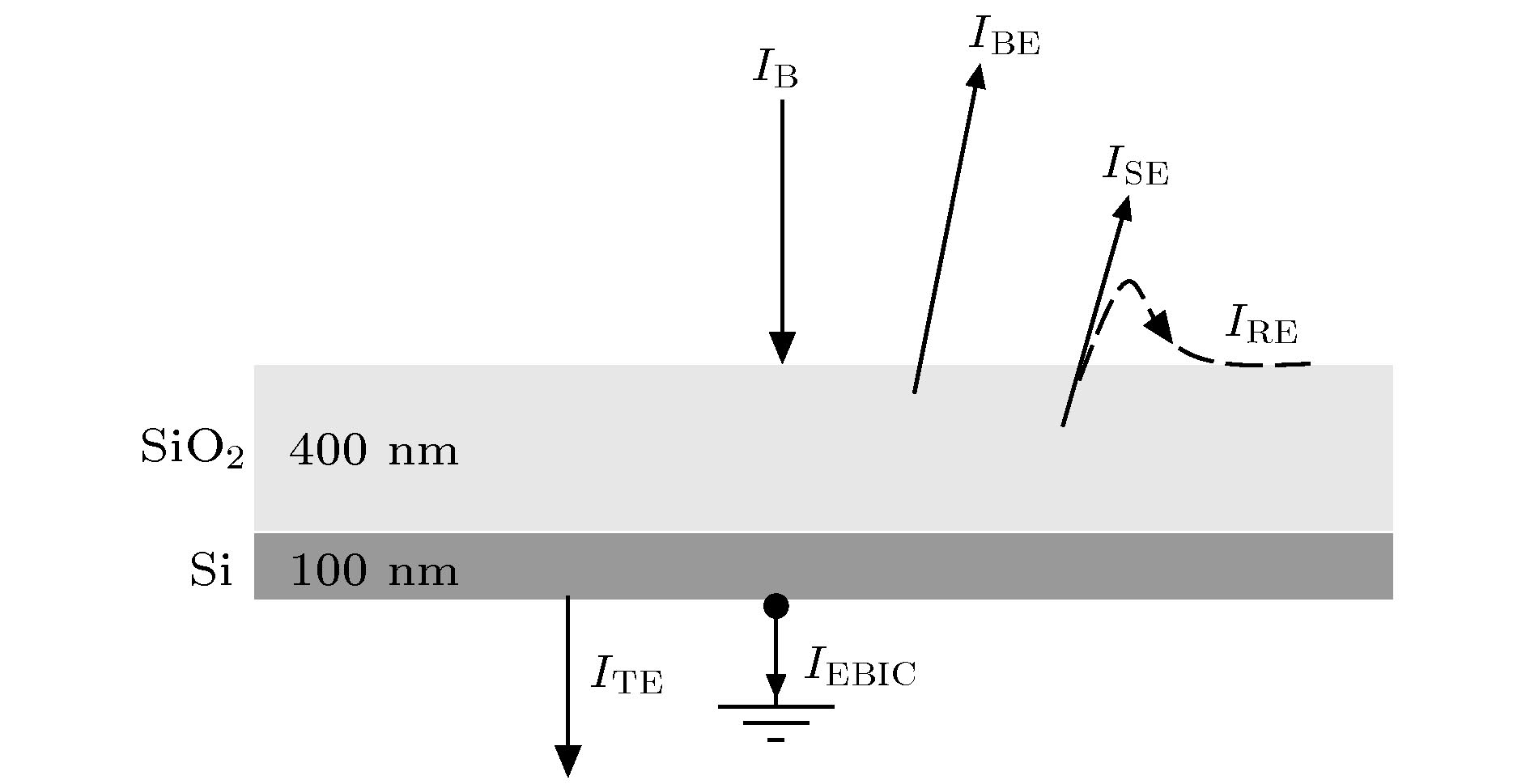
2020, 69 (6): 060201.
doi: 10.7498/aps.69.20191543
Abstract +
The electron beam induced current (EBIC) characteristics of dielectric/semiconductor thin films under the electron beam (e-beam) irradiation is the important means of implementing the electron microscopic detection. The transient EBIC characteristics of the SiO2/Si thin film irradiated by a high-energy e-beam are investigated by combining the numerical simulation and the experimental measurement. The scattering process of electrons is simulated by the Rutherford scattering model and the fast secondary electron model, and the charge transport, trapping and the recombination process are calculated by the current continuity equation and the Poisson equation. The transient charge distribution, EBIC and the transmission current are obtained, and influence of the beam current and the beam energy on them are analyzed. The results show that due to the electron scattering effect, the free electron density decreases gradually along the incident direction. The net charge density near the surface is positive and negative along the incident direction because of secondary electrons (SEs) emitted from the surface, and therefore the electric field intensity is positive near the surface and negative inside sample, which causes some electrons to be transported to the substrate and some SEs return to the surface. The negative charge density at the SiO2/Si interface is higher than that in the nearby region because some electrons are trapped by the interface trap. With the decrease of the net charge density with e-beam irradiation, the charging intensity decreases gradually. Meanwhile, electrons are gradually transported to the substrate, and consequently EBIC and the sample current increase and the electric field intensity decreases with e-beam irradiation. However, due to the weak charging intensity, the surface emission current and the transmission current remain almost invariant with e-beam irradiation. The EBIC, the transmission current and the surface emission current are approximately proportional to the beam current. For the SiO2/Si thin film in this work, the transmission current increases gradually to the beam current value with the increase of the beam energy, and the EBIC presents a maximum value at the beam energy of about 15 keV.

EDITOR'S SUGGESTION
2020, 69 (6): 060301.
doi: 10.7498/aps.69.20191689
Abstract +
Compared with discrete variable quantum key distribution (DVQKD), continuous variable (CV) QKD has high security bit rate and other advantages, which, however, are slightly insufficient in secure transmission distance. In addition, the application of quantum catalysis has significantly improved the performance of Gaussian modulated (GM) CVQKD, especially in secure transmission distance. Recently, the application of quantum catalysis has significantly improved the performance of GM-CVQKD. However, whether it can be used to improve the performance of discrete modulated (DM) CVQKD protocol is still ambiguous. Therefore, a scheme of DM CVQKD protocol based on quantum catalysis is proposed in this paper to further improve the performance of the proposed protocol in terms of secure key rate, secure transmission distance and maximum tolerable noise. Our results show that under the same parameters, when the transmittance T introduced by quantum catalysis is optimized, the proposed scheme can effectively further improve the performance of QKD system compared with the original four-state modulation CVQKD scheme. In particular, when the tolerable excess noise is 0.002, the use of quantum catalysis can break the safe communication distance of 300 km with a key rate of 10–8 bits/pulse. However, if this noise is too large, the improvement in the effect of quantum catalysis on protocol performance will be restrained. In addition, in order to highlight the advantages of the use of quantum catalysis, the ultimate limit PLOB (Pirandola-Laurenza-Ottaviani-Banchi) bound of point-to-point quantum communication is given in this paper. The simulation results indicate that although neither the original scheme nor the proposed scheme can break the bound, compared with the former, the latter can be close to the boundary in long-distance transmission. These results provide theoretical basis for achieving the ultimate goal of global quantum security communication.

EDITOR'S SUGGESTION
2020, 69 (6): 060302.
doi: 10.7498/aps.69.20191765
Abstract +
Currently, most of the experimental apparatuses of atomic gravimeters are complex in structure, large in size, and poor in environmental adaptability, so that they cannot be used to implement the absolute gravity measurement. Thus, the application areas of atomic gravimeter are greatly limited. In this paper, we integrate a system of absolute gravity measurement on a truck based on a compact homemade atomic gravimeter. This atomic gravimeter has a small size, light weight, low power consumption, and its accuracy is estimated as 10 μGal in the case of laboratory environment. This system consists of atomic gravimeter for gravity measurement, passive isolation platform for vibration suppression, posture platform for tilt adjustment, differential GPS for altitude measurement, UPS for power supply, air-conditioned truck for temperature control and transportation. At first, we estimate the performance of environmental adaptability for this measurement system on the truck, and it is found that this system can still work even at a high field temperature of 40 ℃ and a big tilt angle of 8° for the road. Besides, the experimental procedures of absolute gravity measurement and the methods of processing measured data are introduced. The Coriolis effect is analyzed and the dependence of measured gravity on the orientation of the truck has been measured. Finally, the repeated line measurements are performed on a flat field road. The accuracy of self-coincidence for absolute gravity measurement is evaluated to be 30 μGal and the difference in measured gravity among different locations is about 3080 μGal. Besides, we obtain the vertical gravity gradient of the earth by measuring the absolute gravity values at different altitude sites on a slope road, and the value is estimated to be -231(36) μGal/m. The presented results can provide the basic reference for the field absolute gravity survey.

2020, 69 (6): 060501.
doi: 10.7498/aps.69.20191516
Abstract +
From the perspective of physics, evolution of group opinion can be regarded as the collective effect of the state change of opinion particles. It is similar to a material particle system that there is usually a dynamic criticality in the opinion state transition of a group, and is dominated by a scaling law. To exhibit this phenomenon, a bistable potential field is introduced to mimic the opinion transition by the jump from one stable state to the other. In this investigation, we will focus on the state change of the opinion particles induced by the noise. The time correlation function and the relaxation time describing drive-response relationship are calculated, by using of the generalized Laguerre weight complete set of orthogonal functions method, to reveal the regularity and the relative mechanism governing the state change of the opinion particle confined by the bistable potential and affected by the noise. The results indicate that there is a critical value Dc for noise intensity. When the noise intensity is greater than Dc, the time correlation function will increase exponentially with correlation time τ. There also are two points at which the dependence of the relaxation time on the noise intensity/aspect ratio of the energy barrier are divergent. The divergence implies that the state transition of opinion particles cannot be achieved. It is worth noting that there is a linear relationship between the relaxation time and the aspect ratio of energy barrier. This relation means that there is a drive-response relationship for opinion particles in the bistable potential field just like the Newton’s second law, in which the time relaxation plays the role of quasi-inertia. This result also implies another important conclusion that the energy and information may be equated due to the fact that the opinion particle transiting from one stable state to the other needs obtaining energy to climb over the barrier, and from another point of view, the transition can be regarded as the opinion particle having been obtaining information via the noise correlation. These investigations may provide us with new understandings to the evolution of group opinion.

2020, 69 (6): 060701.
doi: 10.7498/aps.69.20191214
Abstract +
At present, numerical methods applied to the coupling analysis of transmission lines on the lossy dielectric layer excited by ambient wave are still rare in the literature. As a temptation to fill this gap, a novel time domain hybrid method is proposed, in which the modified transmission line (TL) equations, finite-difference time-domain (FDTD) method, and some interpolation schemes are organically combined together. It can overcome the difficulty in building the coupling model of ambient wave to transmission lines on the lossy dielectric layer greatly. In this method, the modified transmission line (TL) equations suitable for the coupling analysis of multi-conductor transmission lines (MTLs) on the lossy dielectric layer are derived from the traditional TL equations firstly. Compared with the traditional TL equations, the electromagnetic fields in the lossy dielectric layer are introduced into the equivalent distribution sources of modified TL equations. Generally, the precision of TL equations is dependent on the accuracy of equivalent distribution sources, which are obtained from the incident electric fields parallel and perpendicular to the MTLs. Therefore, the FDTD method is utilized to model the structure of lossy dielectric layer to calculate the electromagnetic field distribution surrounding the MTLs and in the dielectric layer. Since the heights and distances of MTLs can be arbitrary values, the electric fields parallel and perpendicular to the MTLs cannot be obtained from the electric fields on the edges of FDTD grids directly, which should be computed via some interpolation schemes. Then the modified TL equations are established, which should be solved by the central difference scheme of FDTD method to obtain the voltages and currents on the MTLs and terminal loads. The significant feature of this proposed method is that it can realize the synchronous calculations of electromagnetic field radiation and transient responses on the MTLs. Finally, numerical simulations of single and multiconductor transmission lines on the lossy dielectric layer excited by ambient wave at different incident angles are employed to exhibit the accuracy and efficiency of the proposed method by comparing with the simulation software CST. Because the structures of MTLs do not need to be meshed, the proposed method outperforms the simulation software CST in both memory usage and computation time.
NUCLEAR PHYSICS

2020, 69 (6): 062801.
doi: 10.7498/aps.69.20191545
Abstract +
Scintillating array image plates are allowed high resolution through a thicker detector which increases quantum efficiency without degrading the imaging resolution substantially. Due to limitations imposed by process capability, scintillator fiber array with pixel diameter less than 0.2 mm is hardly manufactured to improve performance. Therefore, a liquid scintillator capillary array with 0.1 mm pixel is developed to improve the detection efficiency and spatial resolution of image plate for low intensity radiation imaging. Its performances are studied and tested by simulation and experiment, and are compared with those of scintillating fiber array. Especially in order to gain high fidelity representation of modulation transfer function of the array image plate, a method of simulating and measuring the slanted knife edge response and an iterative algorithm are introduced. For 14 MeV neutron and 1.25 MeV gamma, the slanted knife edge responses of these array image plates with pixel dimensions in a range from 0.1 mm to 0.5 mm are respectively simulated by MCNPx program and the modulation transfer function (MTF) are obtained. The simulation results show that compared with scintillating fiber array, the liquid scintillator capillaries array has an obvious merit in spatial resolution because of greater stopping power for secondary charged particle in the capillary quartz glass wall with 0.02 mm in thickness. Its ultimate resolution can reach to 1.8 lp/mm for 14 MeV neutron by simulation. At the 4000 Ci 60Co facility, a 5-cm-thick tungsten bar, one side of which has a curvature of 0.1 radian to minimize the misalignment effect, is made a knife edge. The MTF of the scintillating fiber array with 0.3 mm and 0.5 mm pixel and newly developed liquid scintillator capillary array is measured through this tungsten knife edge. Experimental measurement results have also verified that the liquid scintillator capillary array performs well in spatial resolution and luminescent uniformity for 1.25 MeV gamma. The ultimate spatial resolution, 0.9 lp/mm is gained, and those of other scintillating fiber arrays are all less than 0.5 lp/mm. Moreover, experimental test validates the simulating method and simulated results, although the measured value is slight less than the simulated value because of the effect of dimension of 60Co source.
ELECTROMAGNETISM, OPTICS, ACOUSTICS, HEAT TRANSFER, CLASSICAL MECHANICS, AND FLUID DYNAMICS

2020, 69 (6): 064201.
doi: 10.7498/aps.69.20191621
Abstract +
The camera array is an important tool to obtain the light field of target in space. The method of obtaining high angular resolution light field by a large-scaled dense camera array increases the difficulty of sampling and the equipment cost. At the same time, the demand for synchronization and transmission of a large number of data also limits the sampling rate of light field. In order to complete the dense reconstruction of sparse sampling of light field, we analyze the correlation and redundancy of multi-view images in the same scene based on sparse light field data, then establish an effective mathematical model of light field dictionary learning and sparse coding. The trained light field atoms can sparsely express the local spatial-angular consistency of light field, and the four-dimensional (4D) light field patches can be reconstructed from a two-dimensional (2D) local image patch centered around each pixel in the sensor. The global and local constraints of the four-dimensional light field are mapped into the low-dimensional space by the dictionary. These constraints are shown as the sparsity of each vector in the sparse representation domain, the constraints between the positions of non-zero elements and their values. According to the constraints among sparse encoding elements, we establish the sparse encoding recovering model of virtual angular image, and propose the sparse encoding recovering method in the transform domain. The atoms of light field in dictionary are screened and the patches of light field are represented linearly by the sparse representation matrix of the virtual angular image. In the end, the virtual angular images are constructed by image fusion after sparse inverse transform. According to multi-scene dense reconstruction experiments, the effectiveness of the proposed method is verified. The experimental results show that the proposed method can recover the occlusion, shadow and complex illumination in satisfying quality. That is to say, it can be used for dense reconstruction of sparse light field in complex scene. In our study, the dense reconstruction of linear sparse light field is achieved. In the future, the dense reconstruction of nonlinear sparse light field will be studied to promote the practical application of light field imaging.

2020, 69 (6): 064202.
doi: 10.7498/aps.69.20191541
Abstract +

EDITOR'S SUGGESTION
2020, 69 (6): 064203.
doi: 10.7498/aps.69.20191793
Abstract +
In recent years, with the increase of information processing capacity of optical networks and the continuous improvement of high-density optical communication technology, the requirements for the performance of light sources are also increased. High-quality VCSEL with beam polarization stability control plays an increasingly important role in the above fields. The combination of liquid crystal and vertical cavity surface emitting laser (VCSEL) array can realize wavelength tunability and precise polarization control. At the same time, the introduction of liquid crystal will also change the thermal characteristics of VCSEL array. In this paper, the structure of VCSEL array is designed and the experimental research on the thermal characteristics of VCSEL array is carried out. The effects of nematic liquid crystal layer on the thermal characteristics of VCSEL array are compared and analyzed. The experimental results show that the threshold current temperature change rate of 1 × 1, 2 × 2 and 3 × 3 surface liquid crystal VCSEL array can be reduced by 23.6% and the thermal resistance can be reduced by 26.75%. Moreover, the saturated optical power of VCSEL array can be improved to a different degree. Meanwhile, the liquid crystal layer can effectively increase the heat transverse conduction and reduce the optical hole. The temperature difference between the light outlet and the table makes the heat conduction time very short at a small distance between the light outlet and the table, which is more conducive to the uniform temperature distribution of the laser array. The experimental results show that the temperature difference between the light outlet and the surrounding is less than 0.5 ℃. To sum up, the introduction of liquid crystal layer into VCSEL array not only greatly accelerates the thermal diffusion of laser array unit, but also reduces the junction temperature of active region, improves the thermal characteristics of VCSELs laser array, and lays a good theoretical and experimental foundation for realizing the high beam quality single polarization wavelength controllable VCSEL laser array.

2020, 69 (6): 064204.
doi: 10.7498/aps.69.20191865
Abstract +
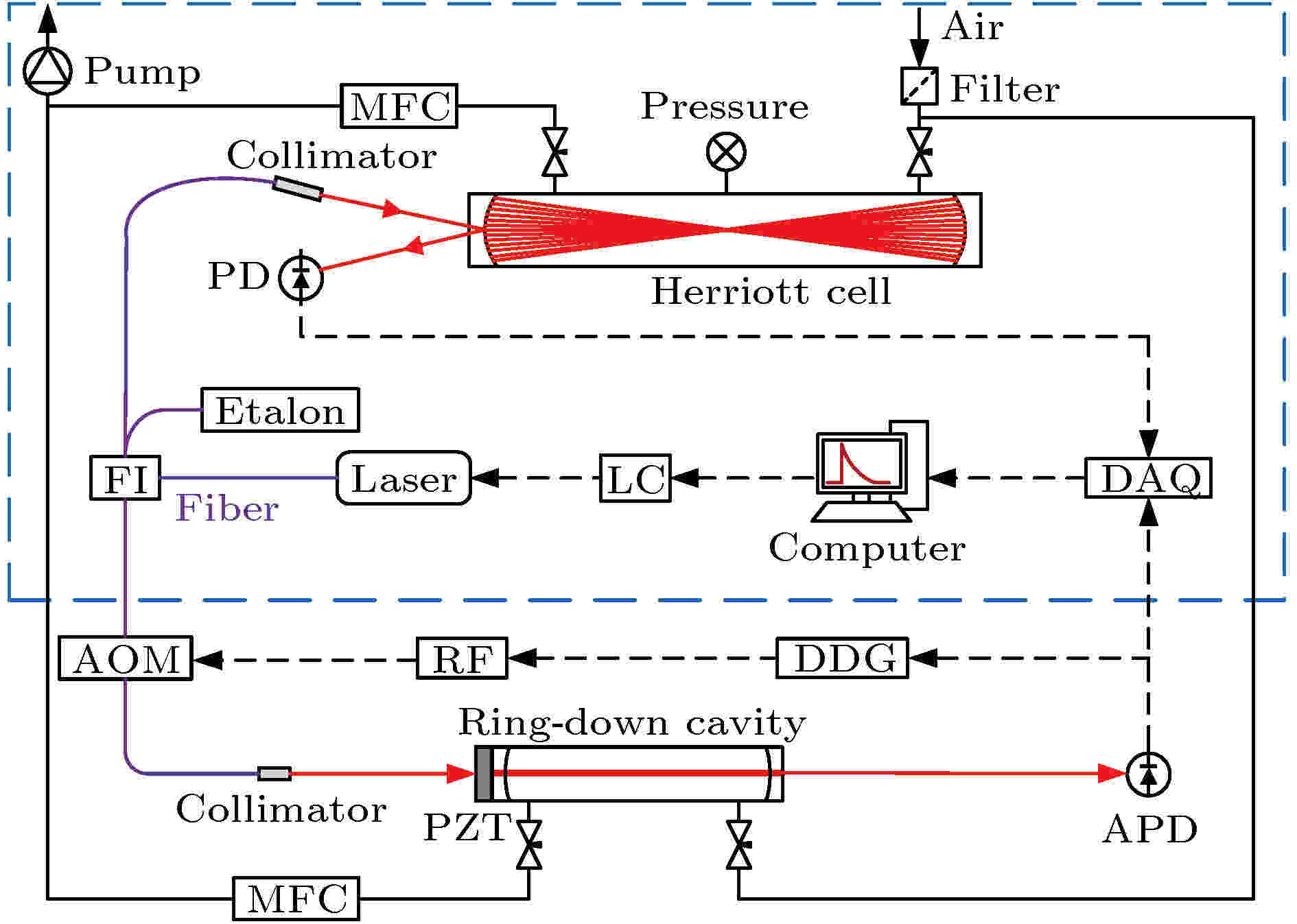
2020, 69 (6): 064205.
doi: 10.7498/aps.69.20191569
Abstract +
Wavelength modulation-direct absorption spectroscopy (WM-DAS) integrates the advantages of measuring absolute absorbance profile from calibration-free direct absorption spectrum (DAS) with the enhanced noise rejection and high sensitivity of wavelength modulation spectrum (WMS). This method can be used to precisely recover the crucial absorbance profile via the extraction of the characteristic frequency of the modulated transmitted light. In this paper, the WM-DAS method with non-calibration and high signal-to-noise ratio is integrated with a Herriott cell (about 128 m). Under the condition of atmospheric pressure and room temperature, the absorptance functions of two spectral lines of CO2 (6330.821 cm–1) and CH4 (6046.964 cm–1) in air are measured, and their standard deviations of spectral fitting residual are 5.6 × 10–5 and 7 × 10–5, respectively. Subsequently, the concentration of CO2 and CH4 in air are monitored on-line by the WM-DAS method integrated with the Herriott cell, and compared with those by the highly sensitive continuous wave cavity ring down spectroscopy (CW-CRDS). The experimental results show that the measured results of the long optical path WM-DAS method are consistent with those by the CW-CRDS method, and the linear correlation between the two methods is above 0.99. The detection limit of CO2 and CH4 by the WM-DAS method are 170 ppb and 1.5 ppb respectively, which are slightly higher than those by the CW-CRDS. However, the measurement speed by WM-DAS is much higher than that by CW-CRDS, and possesses the advantages of simpler operation, lower environmental requirements, long-term stability, etc.

2020, 69 (6): 064206.
doi: 10.7498/aps.69.20190962
Abstract +
Aiming at the high requirements for illumination uniformity on the target in laser-driven inertial confinement fusion (ICF) facilities, an ultrafast smoothing method based on dynamic interference structure between beamlets of a laser quad is proposed. The basic principle of this scheme is to use a conjugate phase plate array to add the conjugate phase modulation to the multiple beamlets of a laser quad with a certain wavelength difference. Consequently, every two beamlets are coherently superposed in the far field to generate a dynamic interference pattern, resulting in the fast redistribution of the speckles introduced by continuous phase plate inside the focal spot and further improving the illumination uniformity on the target on a picosecond timescale. The coherent beamlets with a certain wavelength difference can be generated by using a broadband seed laser. Taking the laser quad of the typical ICF facilities for example, the physical model of the ultrafast smoothing method based on dynamic interference structure of beamlets is built up. The influences of the phase-plate type, the peak-to-valley value of the phase modulation and the wavelength difference between the beamlets are analyzed quantitatively, and the smoothing characteristics of the focal spot are discussed in detail and compared with those from the traditional temporal smoothing scheme such as smoothing by spectral dispersion. The results indicate that the directions of the moving speckles in the focal spot are determined by the phase-plate type. However, the required time to achieve stable illumination uniformity, i.e, the decay time, is determined by the wavelength difference between the beamlets. Moreover, the illumination uniformity on the target becomes better with the increase of peak-to-valley value of the phase modulation at first and then remains almost the same. Thus, the ultrafast smoothing method based on dynamic interference structures with well-designed phase arrays and wavelength combinations of the beamlets can realize the multi-directional and multi-dimensional speckle sweeping inside the focal spot, and further improving the irradiation uniformity on the target within several picoseconds or sub-picoseconds. Combining with the traditional beam smoothing scheme, better illumination uniformity can be achieved on an ultrashort timescale. This novel scheme can be used as an effective supplement to the existing temporal beam smoothing techniques.
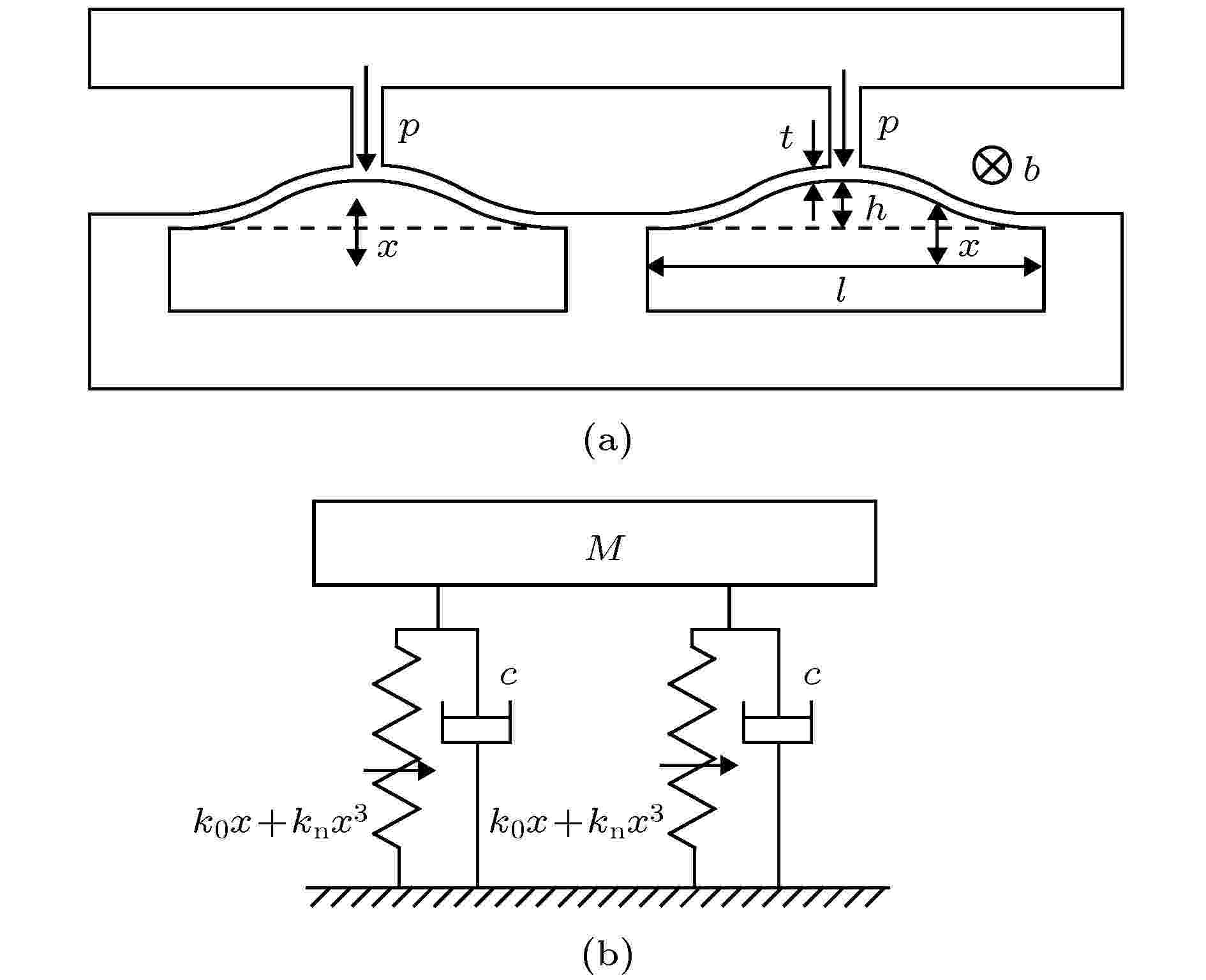
2020, 69 (6): 064301.
doi: 10.7498/aps.69.20191082
Abstract +
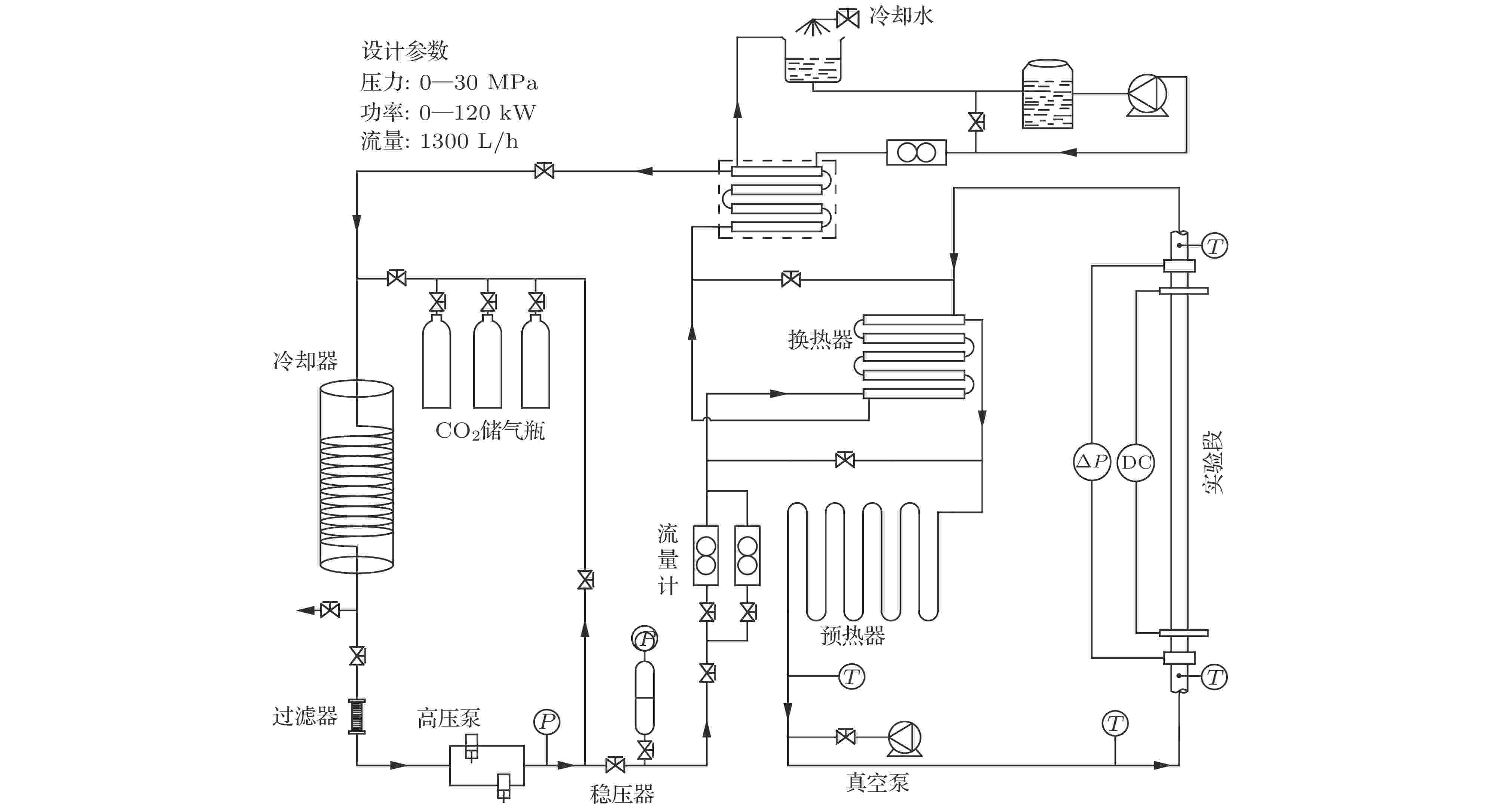
2020, 69 (6): 064401.
doi: 10.7498/aps.69.20191521
Abstract +
Based on the concept of single-phase fluid, the abnormal heat transfer behavior of supercritical fluid has been investigated for many years. However, there is no unified understanding of the mechanism of its flow and heat transfer. In this paper, we first review the reported effects of buoyancy and acceleration on supercritical fluids, and then study the effects of buoyancy and acceleration on the flow structure and heat transfer for the upward vertically flowing of supercritical CO2 fluid in a tube theoretically and experimentally. The results show that there is no conclusive experimental evidence that the abnormal heat transfer behavior of supercritical fluid is directly related to buoyancy and flow acceleration, and the existing criteria for estimating buoyancy and acceleration effect are based on the constant physical fluid and a lot of assumptions, as a result, different conclusions are obtained, though the same prediction method is used. Finally, we investigate the heat transfer deterioration of supercritical fluids based on the pseudo-boiling theory, and the proposed supercritical-boiling-number distinguishes the normal heat transfer deterioration from heat transfer deterioration of supercritical fluid. Our work paves a new way to understanding the supercritical fluid flow and heat transfer mechanism. The supercritical-boiling-number is important for establishing the optimum operating conditions for the supercritical fluid power cycle used in different technologies.

2020, 69 (6): 064501.
doi: 10.7498/aps.69.20191251
Abstract +
For the physical phenomenon of high-speed car following in the road traffic flow, all the vehicles with small spacing do not run at low speed. The speeds of the vehicles are significantly higher than those they normally should be when they are in this vehicles’s density. There are more than 7% of high-speed following vehicles in the measured data. At present, the traditional traffic flow model cannot simulate the phenomenon of high-speed car following, so a new nonlinear dynamic mathematical model is needed to describe and analyze the physical phenomenon. In order to study the physical phenomenon of high-speed car following in road traffic, a traffic flow dynamics model for simulating the phenomena is proposed, which combines with the prospect theory and takes into account some factors such as driver’s decision-making behavior and randomization. It is called HCCA (high-speed car following celluar automat) model. In the model, the prospect theory is used to analyze the driver’s lane changing behavior under the uncertain conditions. Combined with the characteristics of the radical driver, the dynamic prediction speed is considered for the front car followed by the radical driver, and the HCCA dynamics rules of high-speed following traffic flow mechanics are defined. By the computer numerical simulation, the evolution mechanism and the characteristics of high-speed car-following flow are studied. The results show that compared with the symmetric two-lane cellular automata (STCA) dynamic model, the HCCA dynamic model established in this paper can simulate abundant traffic physical phenomena, and reproduce complex traffic phenomena such as free flow, synchronous flow and wide-range motion congestion. Finally, the phenomenon of high-speed car following is simulated and the results of high-speed car following rate over 7% with small spacing are in good agreement with the measured results. It overcomes the shortage that traditional STCA model cannot simulate the synchronous flow. It is found that the larger the proportion of radical drivers, the larger the high-speed car following rate and traffic flow with small spacing are under the same road density. The high-speed car following traffic flow mechanics model proposed in this paper has a certain reference significance and practical value for analyzing the physical phenomenon of high-speed car following and enriching the traffic flow theory.
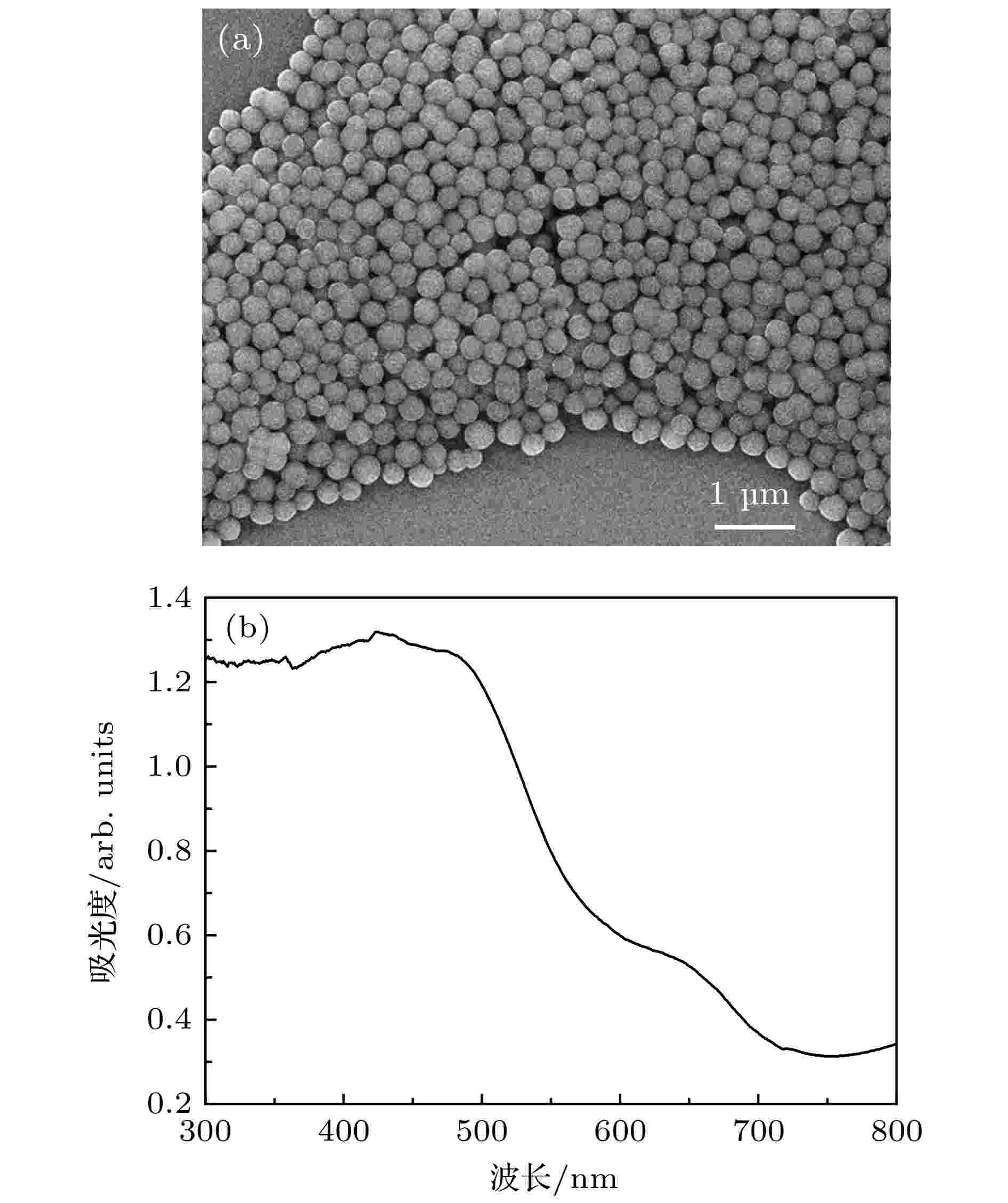
2020, 69 (6): 064701.
doi: 10.7498/aps.69.20191508
Abstract +
Adding nanoparticles with high light response characteristics to a light-transmitting fluid medium can form a light-driven nanofluid and achieve efficient use of light energy. This paper conducts the experimental observation and theoretical analysis of the light driven nanofluid flow behavior, which is the theoretical basis for achieving the precise control of optical drive nanofluid. To realize the efficient conversion of light energy into kinetic energy, here, the motion of Fe3O4 particles with a diameter of 300 nm in droplets induced by the Marangoni effect is studied under different light sources by using the particle image velocimetry (PIV). The experimental results show that when the number density of particles is higher than the critical value, the vertical vortices with symmetrical structure can be induced. At the bottom of the droplet, the particles move from the periphery to the center of droplet, and at the top of the droplet, the particles move from the center to the periphery of droplet. In addition, the frequency of light source and the number density of particles are the dominant factors in this process. Subsequently, for the light driven nanofluid experiment in this paper, the analytical solution of the flow field distribution is achieved by using the Stokes equation and the surface tension gradient boundary condition. The analytical solution of the flow field distribution obtained here is consistent with the experimental results, confirming the validity of the quantitative theory. Finally, the correlation between various driving modes, including surface tension at the top surface, surface pressure at the bottom surface or concentrated light radiation force in bulk phase, is discussed. This research provides theoretical support for the precise regulation of flow behavior and efficient conversion of light energy in the optical microfluidic system.
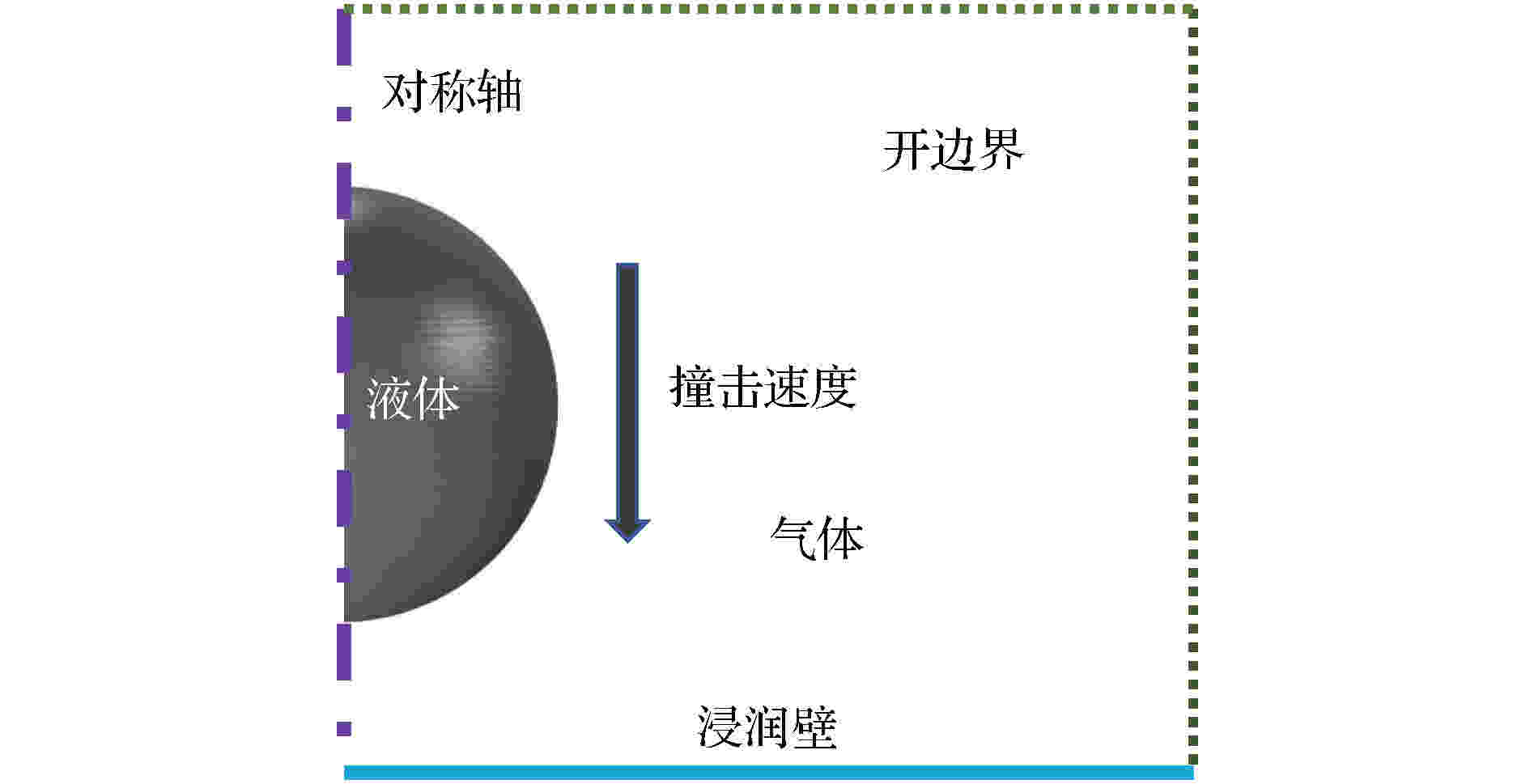
2020, 69 (6): 064702.
doi: 10.7498/aps.69.20191682
Abstract +
Controlling impact dynamics of droplets on solid surfaces is a significant problem in a variety of applications, such as inkjet printing, spray cooling and coating and so on. Most of fluids used in industries always contain various kinds of additives such as surfactants, polymers and particles. Therefore, these fluids exhibit non-Newtonian behaviors, for instance, yield-stress, viscoelastic, shear-thickening and shear-thinning. The impact dynamics of Newtonian droplets on solid surfaces has been extensively investigated. However, the number of researches about fluids with non-Newtonian properties is comparatively very small. In this work, we employ the finite element scheme coupled with level set method to simulate the impact process of droplets on solid surfaces. The numerical simulation models the presence of shear-thinning viscosity by using the truncated power-law rheological model. We first conduct a mesh convergence study and verify the numerical model. The simulation results are found to be in good agreement with experimental data in the literature. By performing extensive numerical simulations and varying the rheological parameters and surface wettabilities, the influences of these parameters on the impact dynamics are evaluated, and the dominant effects that govern the spreading and receding process are determined. The simulation results show that for the case of droplet impacting on surface with contact angle θ = 55°, the spreading is stronger with power-law index decreasing as evidenced by larger shape deformation and faster interface moving speed. As power-law index decreases, we expect the maximum dimensionless diameter to increase and the minimum dimensionless height to decrease during inertial spreading. For the case of droplet with lower power-law index (m = 0.85 and 0.80), which indicates lower viscous dissipation during impact, the dimensionless parameters have significant differences. After first receding, the impacting droplet is not balanced any more and it starts to spread again until its kinetic energy is completely damped by fluid viscous dissipation. For the case of droplet (m = 0.80) impacting on surface, the center breakage can be observed during droplet spreading, which results from the effect of strong shear-thinning property. When a shear-thinning droplet impacts on a surface with contact angle θ = 100°, the oscillation behavior can be observed and the oscillation amplitude increases as power law index decreases. Bouncing phenomenon can be observed when a droplet impacts on surface with contact angle θ = 160°, regardless of rheological property. Finally, we propose an empirical model to predict the maximum dimensionless diameter of shear-thinning droplet impacting on the surface with contact angle θ = 55° as a function of non-Newtonian Reynolds number Ren.
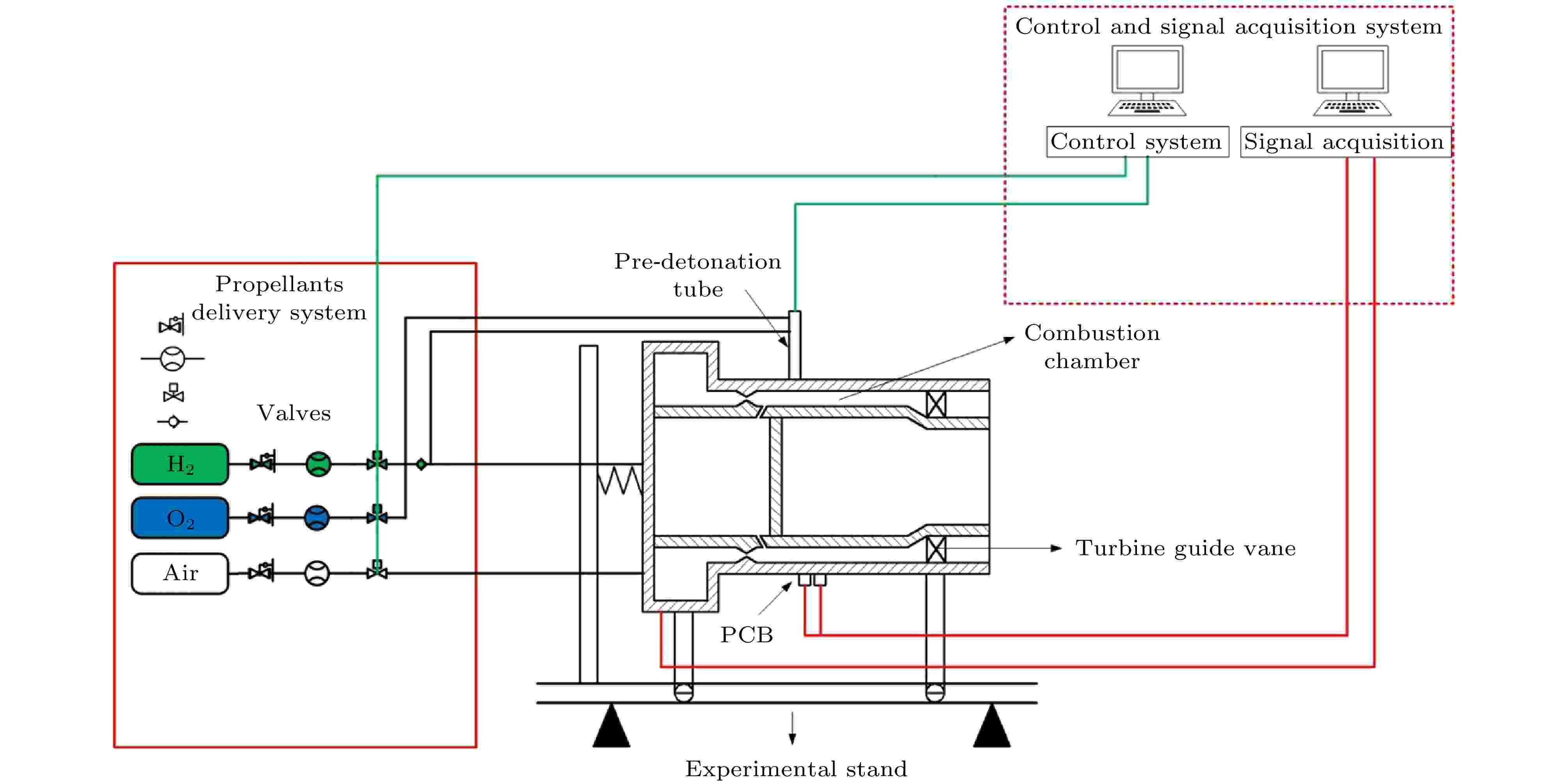
2020, 69 (6): 064703.
doi: 10.7498/aps.69.20191547
Abstract +
Detonation is a supersonic combustion in which a shock wave propagates driven by an energy release in a reaction zone. Compared with deflagration, detonation has high thermodynamic efficiency and fast heat release rate. The traditional propulsion system based on the isostatic combustion is relatively mature, and its performance is very difficult to further improve. Therefore, detonation is expected to improve the performance of the propulsion system. Replacing the isobaric combustion chamber of turbojet engine with rotating detonation combustor can not only improve the combustion chamber efficiency, but also reduce the number of compressor stages, reduce the weight of engine and simplify the structure of engine. In order to study the operation characteristics of rotating detonation combustor with a turbine guide vane, a series of experiments is conducted, with hydrogen used as fuel and air as oxidant at different equivalence ratios. Based on the signals of high frequency pressure sensor and static pressure sensor, the operation mode of rotating detonation combustor and the effect of a turbine guide vane on the inhomogeneous and unstable detonation products are analyzed in detail. The experimental results show that when the equivalent ratio is less than 0.5, the rotating detonation combustor operates in a rapid deflagration mode and the pressure of combustion wave is about 0.6 bar (1 bar = 105 Pa). The rotating detonation combustor begins to operate in an unstable rotating detonation mode when the equivalence ratio increases to 0.6, and the pressure of detonation wave is about 6 bar. The rotating detonation combustor operates in a stable rotating detonation mode when the equivalence ratio reaches 0.82, and the pressure of detonation wave is about 16.3 bar. In addition, the propagation velocity gradually increases and the stability improves with the increase of the equivalence ratio. The oblique shock wave interacts with the turbine guide vane, and part of the oblique shock wave is reflected back to combustor, which causes some small pressure fluctuations in combustor. The turbine guide vane can obviously suppress the amplitude of pressure oscillation, but has little effect on the frequency of pressure oscillation. The upstream and downstream static pressure of the turbine guide vane increase simultaneously with equivalence ratio increasing. Furthermore, the static pressure of detonation products decreases obviously after passing through the turbine guide vane.
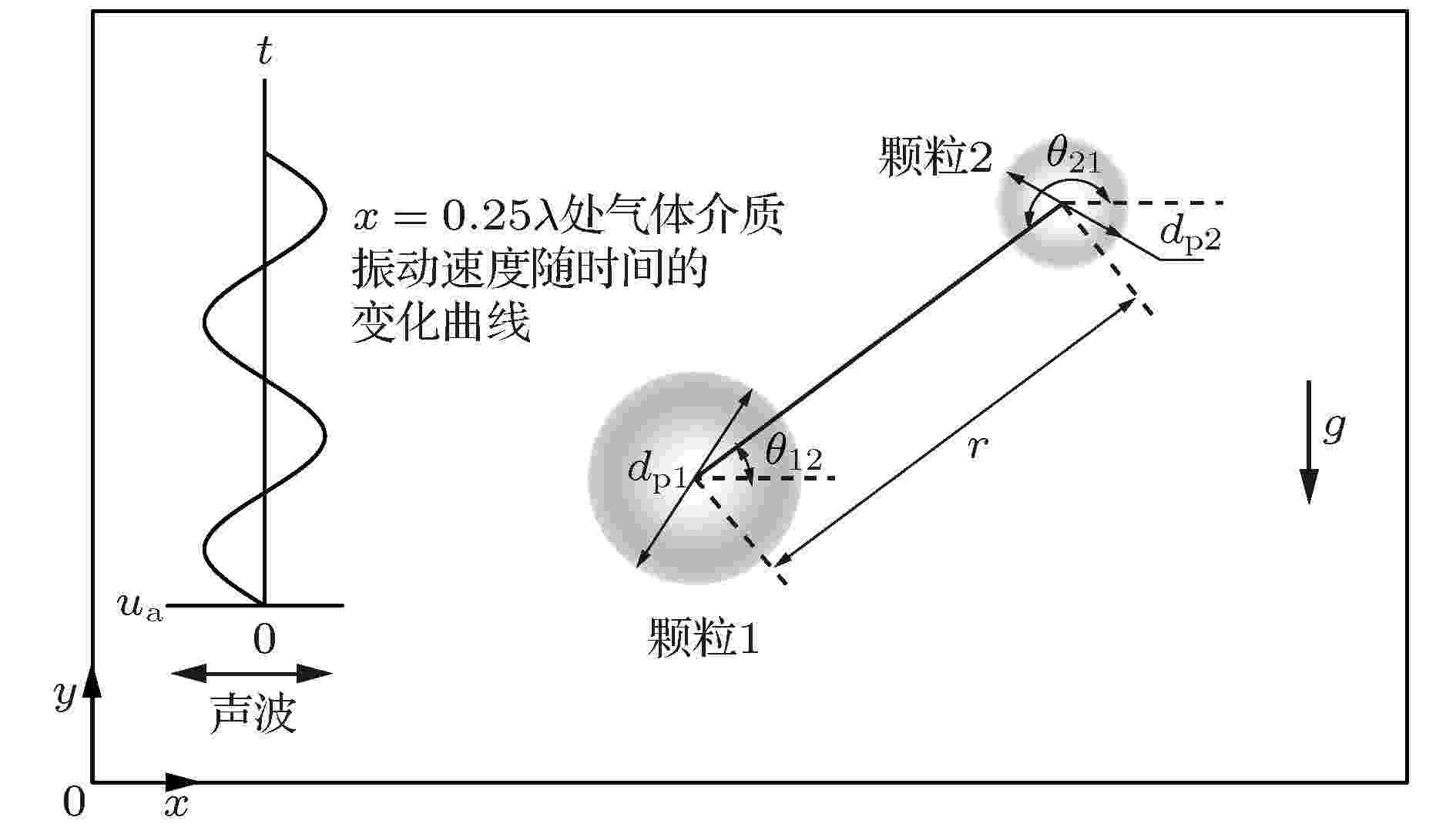
2020, 69 (6): 064704.
doi: 10.7498/aps.69.20191681
Abstract +
The external acoustic field can be used to promote the interactions between fine particles suspended in the gas phase. Due to the particle interaction, collision and agglomeration between fine particles occur, causing the average particle size to increase and the particle number concentration to decrease. This offers an important technical route to controlling the emissions of fine particles. However, the interaction behaviors between the fine particles under the acoustic field are still not well understood, which severely hinders the technology from developing for fine particle emission control by using acoustic agglomeration. In order to reveal the interaction between monodisperse fine particles in a standing wave acoustic field, a particle interaction model with consideration of the drag force, gravity and acoustic wake effect is developed. The particle motion equations in the model are solved by using the classical Runge-Kutta method combined with the second-order implicit Adams interpolation method. The particle velocity due to acoustic entrainment and the interaction process between particles obtained from the numerical simulation are compared with the corresponding analytical solutions and experimental results to validate the accuracy of model prediction. Good agreement is found, which indicates that the model and the numerical method are capable of accurately predicting the interaction between fine particles in the standing wave acoustic field. On this basis, the effects of initial conditions and diameters of particles on the interaction behaviors are explored. The results show that when the initial particle centerline is closer to the acoustic wave direction or the initial particle position is closer to the wave antinode, the acoustic wake effect between the particles becomes stronger, and shorter time is required for particles to collide. It is also found that the influence of particle diameter on particle interaction depends on the initial deviation of particle centerline from the acoustic wave direction. When the deviation is small, the larger the particle diameter, the shorter the time required for particles to collide is. When the deviation is large, the collision between particles with smaller diameters occurs, while the collision between particles with larger diameters may not occur.

2020, 69 (6): 064705.
doi: 10.7498/aps.69.20191755
Abstract +
The gas-lift system has a lot of significant advantages in sewage treatment, deep well oil recovery, liquid metal cooled reactor and magnetohydrodynamic power converters. The densities of different liquid media and gas media have great influences on the performance of gas lift system. Therefore, based on Fluent simulation software, using Euler model and k-ω SST (shear stress transport) turbulence model, the gas-liquid two-phase flow behaviors in nitrogen-water, nitrogen-kerosene, nitrogen-mercury and air-water, argon-water, nitrogen-water of gas lift system are studied. The rules of gas volume fraction and liquid flow rate at lifting pipe, liquid radial velocity at lifting pipe outlet, promoting efficiency are analyzed. The results are shown as follows. 1) In the nitrogen-water, nitrogen-kerosene and nitrogen-mercury system, the higher the density of liquid medium, the smaller the gas volume fraction in the lifting pipe is; the greater the flow rate of lifting liquid, the higher the promoting efficiency is. 2) In the air-water, argon-water and nitrogen-water systems, the higher the density of gas medium, the smaller the gas volume fraction in the lifting pipe is; the larger the flow rate of lifting liquid, the smaller the peak value of promoting efficiency is. 3) With the increase of gas flow rate, the liquid radial velocity at the lifting pipe outlet increases with overall fluctuation rising. Finally, the liquid velocity near the center of pipe axis is large, near the pipe wall is small. These research results provide the scientific theoretical basis for optimizing the gas lifting technology in applications such as sewage treatment, deep well oil recovery, liquid metal cooled reactor and magnetohydrodynamic power converters.
PHYSICS OF GASES, PLASMAS, AND ELECTRIC DISCHARGES

2020, 69 (6): 065201.
doi: 10.7498/aps.69.20191522
Abstract +
In this paper, the highly ordered periodic silver nanosphere arrays are fabricated by vacuum evaporation based on anodic aluminum oxide (AAO) template. The diameter and spacing of silver nanosphere in the arrays are adjusted just by controlling the thickness of evaporation. Furthermore, this can effectively modulate the absorption peaks and bandwidths in ultraviolet-visible-near-infrared regions. The measurement results of absorption spectra show that the nano-arrays have obvious electromagnetic wave absorption characteristics in the ultraviolet, visible and near-infrared bands. The finite-difference time-domain theoretical simulation combined with experiments is used to analyze the physical mechanism of light absorption characteristics in different wavebands. The ultraviolet strong absorption is due to the Fano resonance induced by asymmetric dielectric environment of silver and aluminum; the visible absorption originates from local surface plasmon resonance of silver nanoparticles; the near-infrared strong absorption is attributed to the surface lattice resonance of silver nanosphere arrays.
CONDENSED MATTER: ELECTRONIC STRUCTURE, ELECTRICAL, MAGNETIC, AND OPTICAL PROPERTIES
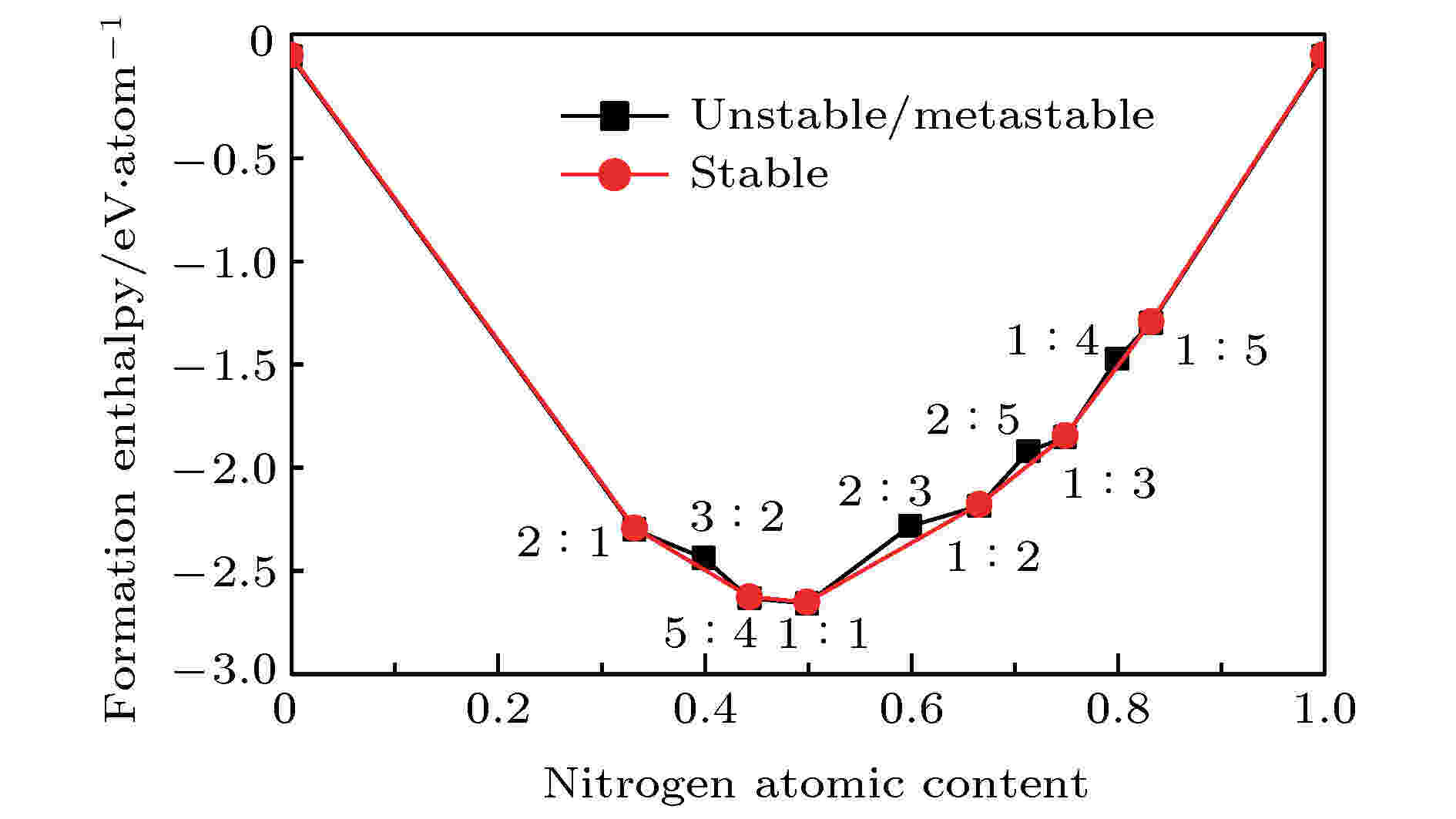
COVER ARTICLE
2020, 69 (6): 067101.
doi: 10.7498/aps.69.20191808
Abstract +
Recent studies have shown that introducing metal elements into nitrogen matrix can induce more stable poly-nitrogen structures than the pure nitrogen phase due to the ionic interaction between metal elements and nitrogen matrix. Many types of poly-nitrogen structures have been reported by using the alkaline earth metal elements (M = Be, Mg, Ca, Sr, Ba) as the coordinate elements. For example, the one-dimensional (1D) infinite armchair poly-nitrogen chain (N∞) structure and N6 ring structure are obtained for the MN4 and MN3 chemical stoichiometry, respectively. Interestingly, the stabilities of theses MNx structures are enhanced 2–3 times compared with that of the pure nitrogen. Therefore, exploring the novel and stable poly-nitrogen structure by introducing alkaline earth metal elements under high pressure is a great significant job. As an alkaline earth element, Ca is abundant in the earth. Its ionization energy (I1 = 590 kJ/mol) is far lower than that of Be (900 kJ/mol) and Mg (738 kJ/mol), which means that Ca can form calcium nitrides more easily. Zhu et al. (Zhu S, Peng F, Liu H, Majumdar A, Gao T, Yao Y 2016Inorg. Chem. 55 7550) proposed that the Ca-N system can obtain poly-nitrogen structures under high pressure, such as CaN4 structure with armchair nitrogen chain, CaN5 and CaN3 consisting of pentazolate “N5” and benzene-like “N6” anions. These poly-nitrogen structures have potential applications in the field of high energy density materials. Here, we report the prediction of Ca-N system at 100 GPa by using particle swarm optimization algorithm technique for crystal structure prediction. A new thermal stable phase with P 21/c-Ca5N4 space group is found at 100 GPa, which enriches the phase of Ca-N system under high pressure. The dynamic stability and mechanical stability of new phase are confirmed by phono dispersion spectrum and elastic constant calculations. The electron localization function analysis shows that the nitrogen atoms in P 21/c-Ca5N4 are bonded by N—N single bond and electron transfer from Ca atom to N atom enables Ca5N4 to serve as an ionic-bonding interaction structure. Band structure calculation shows that the Ca5N4 has a semiconductor structure with a direct band gap of 1.447 eV. The PDOS calculation shows the valence band near Fermi energy is mainly contributed by N_p electrons, while the conduction band is mainly contributed by Ca_d electrons, indicating that electrons are transferred from Ca atom to N atom. Bader calculation shows that each N atom obtains 1.26e from Ca atom in P 21/c-Ca5N4. The Raman spectrum and X-ray diffraction spectrum are calculated and detailed Raman vibration modes are identified, which provides theoretical guidance for experimental synthesis.
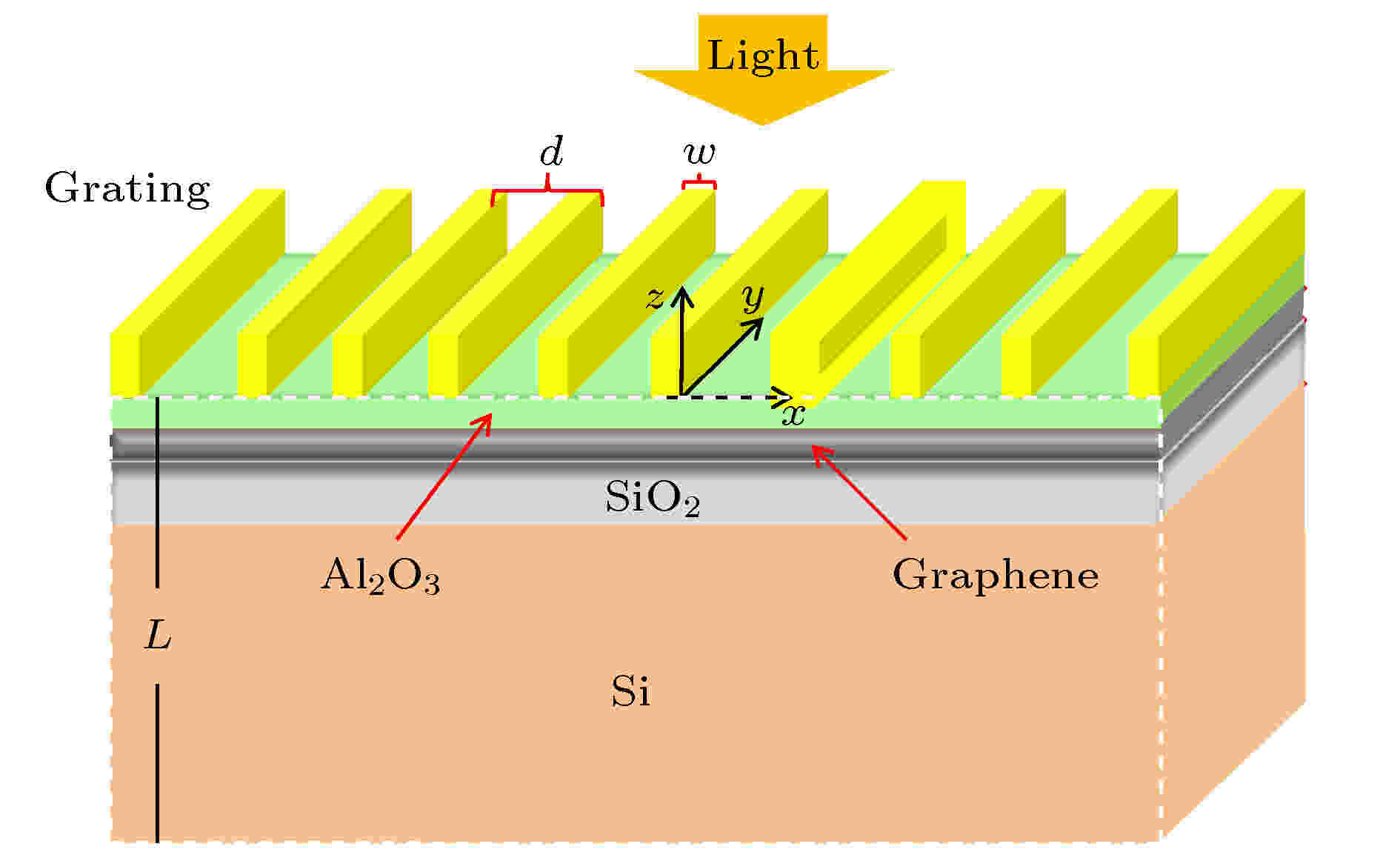
2020, 69 (6): 067801.
doi: 10.7498/aps.69.20191645
Abstract +
The plasmons in graphene have the superior properties to metal surface plasmons, such as high field confinement, low Ohmic loss and long wave propagation, highly tunable via electrostatic. More importantly, the frequency of plasmons ranges from terahertz to infrared which indicates that graphene is an ideal candidate for terahertz plamsonics. On the other hand, the strong coupling between incident photons and plasmons in graphene can lead the optical absorption to be enhanced. However, it is difficult for light to couple directly with plasmons in graphene, for the momentum of incident photons cannot match the plasmons in graphene. A metal grating can be used to compensate for the momentum of photons so that it can match that of plasmons in graphene. In this work, we theoretically investigate the effect of plasmons on the terahertz optical absorption of graphene with grating based on finite difference time domain. A great enhancement of electric field component of light field can be obtained near the gold grating strip in the sheet of graphene. Thus, the photons, of which the momentum is compensated for by the grating, can strongly couple with plasmons in graphene. An obviously decrease of the transmission of the graphene structure can be seen at the resonant frequency. The transmission peak corresponds to the resonant frequency spliting into two peaks due to the fact that two plasmon polariton modes are formed by the coupling of photons and palsmons. So we also study the plasmon polariton modes made by coupling photon with palsmon based on the many-body self-consistent method. Two plasmon polariton modes are obtained and an obviously splitting at the resonant frequency can be seen due to the coupling between photons and plasmons. The work conduces to deepening the understanding of the photoelectric properties of graphene and the terahertz plasmonics based on graphene.
INTERDISCIPLINARY PHYSICS AND RELATED AREAS OF SCIENCE AND TECHNOLOGY

2020, 69 (6): 068401.
doi: 10.7498/aps.69.20191222
Abstract +
Quasi-optical confocal cylindrical waveguide possesses a lot of good characteristics, such as big power capacity and low mode density, which can suppress the mode competition in beam-wave interaction. So quasi-optical waveguide has a great advantage in designing high harmonic terahertz gyrotrons. For the reason that part of electron beams located in a region of weak field intensity play a limited role in beam-wave interactions, the beam-wave interaction is not efficient in confocal cavity. Motivated by enhancing the beam-wave interaction efficiency of quasi-optical gyrotron, we propose a novel terahertz harmonic gyrotron cavity with double confocal waveguide in this paper. The transverse field distribution and the mode spectrum in double confocal waveguide are analyzed and presented. A 330 GHz second harmonic gyrotron with double confocal cavity is designed, theoretically analyzed and simulated by using a particle-in-cell (PIC) code. The results obtained for double confocal cavity are compared with the results for single confocal cavity, and the physical mechanism of beam-wave interaction enhancement in double confocal cavity is discussed. Theoretical results show that the double confocal cavity is able to increase the coupling strength of beam-wave interaction, thus, to improve the output power and the interaction efficiency of quasi-optical gyrotron. The PIC simulation results suggest that a high-order waveguide mode in double confocal cavity can steadily interact with the high harmonic cyclotron mode of electron beam without mode competition. Driven by a 40 kV, 2 A electron beam with a guiding center radius of 1.65 mm and velocity ratio equal to 1.5, output power of 9.9 kW at 328.93 GHz can be generated in the designed double confocal cavity. The beam-wave interaction efficiency increases from 5.3% in single confocal cavity to 12.4% in dual confocal cavity under the same operation parameters. The double confocal cavity has great potential applications in terahertz band. Moreover, this study indicates that the eigen mode in double confocal waveguide is a kind of hybrid mode superimposed by two independent single confocal waveguide modes. This mode characteristic will be beneficial to designing a multifrequency gyrotron oscillator operated in two modes and two cyclotron harmonics, simultaneously, with a single electron beam used, which provides a new possibility to develop the novel terahertz radiation source.

EDITOR'S SUGGESTION
2020, 69 (6): 068501.
doi: 10.7498/aps.69.20191420
Abstract +
Metallic photocathodes have drawn attention due to their outstanding performances of ultrafast photoelectric response and long operational lifetime. However, due to their high work function and the large number of scattering events, metallic photocathodes typically are driven by ultraviolet laser pulses and characterized by low intrinsic quantum efficiency (QE). In this work, a new type of Mie-type silver (Ag) nano-sphere resonant structure fabricated on an Ag/ITO composite substrate is used to enhance the photocathode QE, where Mie scattering resonance is used to enhance the local density of optical state and then to improve the light absorption and electron transporting efficiency in Ag nano-spheres. The cesium (Cs) activation layer is also used to lower the electron work function and then to excite photoemission in the visible waveband for Ag photocathode. The optical characteristics of Ag nano-sphere arrays are analyzed by using finite difference time domain method. For the investigated Ag nano-sphere array, theoretical results show that Mie-type electric dipole resonance modes can be obtained over the 400–600 nm waveband by adjusting the sphere diameter, and the large resonance-enhanced absorption can be achieved in nanospheres at the resonance wavelength. The Ag nano-spheres are fabricated on the Ag/ITO substrate by magnetron sputtering and annealing process, then the Cs activation layer is deposited on surface, and finally QE is measured in an ultra-high vacuum test apparatus. Experimental results show that over 0.35% of QE is obtained for Ag nano-sphere particle (with a diameter of 150 nm) at a wavelength of 425 nm, and the wavelength positions of QE maxima are in agreement with Mie resonance for corresponding geometry predicted from the computational model. Given these unique optoelectronic properties, Ag nanophotonic resonance structured photocathodes represent a very promising alternative to photocathodes with flat surfaces that are widely used in many applications today.

2020, 69 (6): 068701.
doi: 10.7498/aps.69.20191536
Abstract +
In the field of astronomical high resolution imaging, adaptive optical correction and image restoration are necessary, and these two techniques can be used either separately or jointly to improve the quality of observed images. However, for a long time, adaptive optics and image restoration technology have been developing independently because they belong to different research fields, and even though they are combined together, it is just a simple splicing of the two technologies, with no crossover between the two. Such a control method results in adaptive optical correction producing only the best possible intermediate result—optical imaging, but is out of control for the final result—restored image. Therefore, it is of great significance to study a control method that combines the two methods in order to obtain the high-quality restored image. In this paper, the traditional hybrid method (adaptive optics + image post-deconvolution) is analyzed and its defects are expounded. The idea of combining adaptive optics and image restoration for system analysis is proposed for the first time, and the concept of correction degree of deformable mirror (the scaling ratio of control voltage of deformable mirror to that of traditional control voltage) is proposed. By changing the degree of correction, the correction residual of the deformation mirror and the detection error of the wavefront sensor can be adjusted. It is proved that there exists an optimal value of the quality of the reconstructed image in the direction of reducing correction degree, and a new control method is obtained by using the optimal correction degree to correct the control voltage of the deformation mirror. For the application in point target imaging, the simulations are carried out with 37-element and 61-element deformable mirrors under several typical wavefront aberrations, and the results show that this method can obtain a better restoration image than traditional methods. This method has more potential applications in adaptive optical systems with large fitting residuals. The idea that adaptive optics and image restoration are considered as a whole, has not been reported in the literature before, so the work of this paper provides a new way of thinking for the research in related fields.
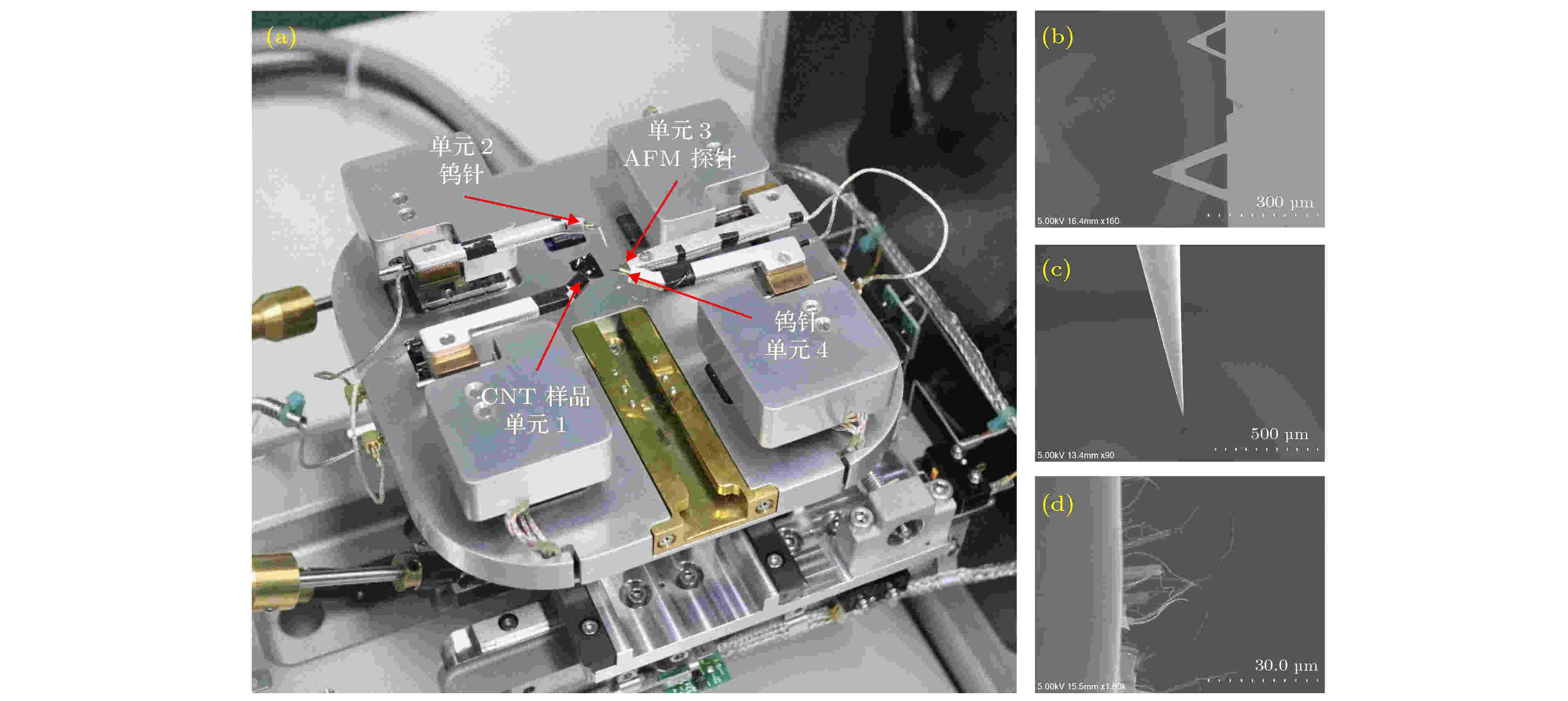
2020, 69 (6): 068801.
doi: 10.7498/aps.69.20191298
Abstract +
In this paper, a length-controllable picking-up method of carbon nanotubes (CNTs) is proposed and the electrical performance data utilized for the conductivity analysis of CNT are also obtained. The micro-nano-operation system inside scanning electron microscope (SEM) is composed of 4 manipulation units each with 3 degrees of freedom, which is driven by piezoelectric ceramics and flexure hinges. In this micro manipulation system, an atomic force microscope (AFM) probe is used as the end effector to adjust the spatial pose of the CNT based on van der Waals force and two tungsten needles are used to cut the CNT from the target length and to measure the I-V characteristic data simultaneously. At first, the AFM probe is moved in the z direction to approach to the CNT until the end of the CNT is adsorbed onto the surface of the AFM probe. And then the AFM probe moves alternately in the x and z direction in order to stretch the CNT into a horizontal straight line, only in this way can the length of the CNT be measured accurately and can the cutting position be determined. Two tungsten needles cleaned by using hydrofluoric acid to remove the oxide layer are controlled to contact both sides of the cutting position on CNT and connected to the TECK 2280S power supply through the electric cabinet to apply a gradually increasing DC voltage, and the current in the circuit is measured and recorded by the TECK DMM7510 until the current abruptly changes to zero which indicates that the CNT between the tungsten needles has been cut off. The stress of the CNT in contact with the tungsten needles and the AFM probe are analyzed. The modeling of van der Waals force between AFM probe and CNT which can influence the pick-up length error caused by the deformation of CNT under the force of tungsten needles is completed. It is found that the contact length of them and the pick-up length error decrease while the van der Waals force between the AFM probe and CNT increases. The circuit models for contact between the tungsten needles and three operating objects, such as semiconducting CNT, metallic CNT and CNT bundle, are also established. In addition, the I-V characteristic equations of circuit model which can be used to fit the I-V data are derived separately. The CNT pick-up experiment is carried out and the results demonstrate that the proposed picking method can control the length of CNT effectively, but the conductivity of CNT can also be judged by fitting the I-V obtained experiment data through the derived I-V characteristic equations.
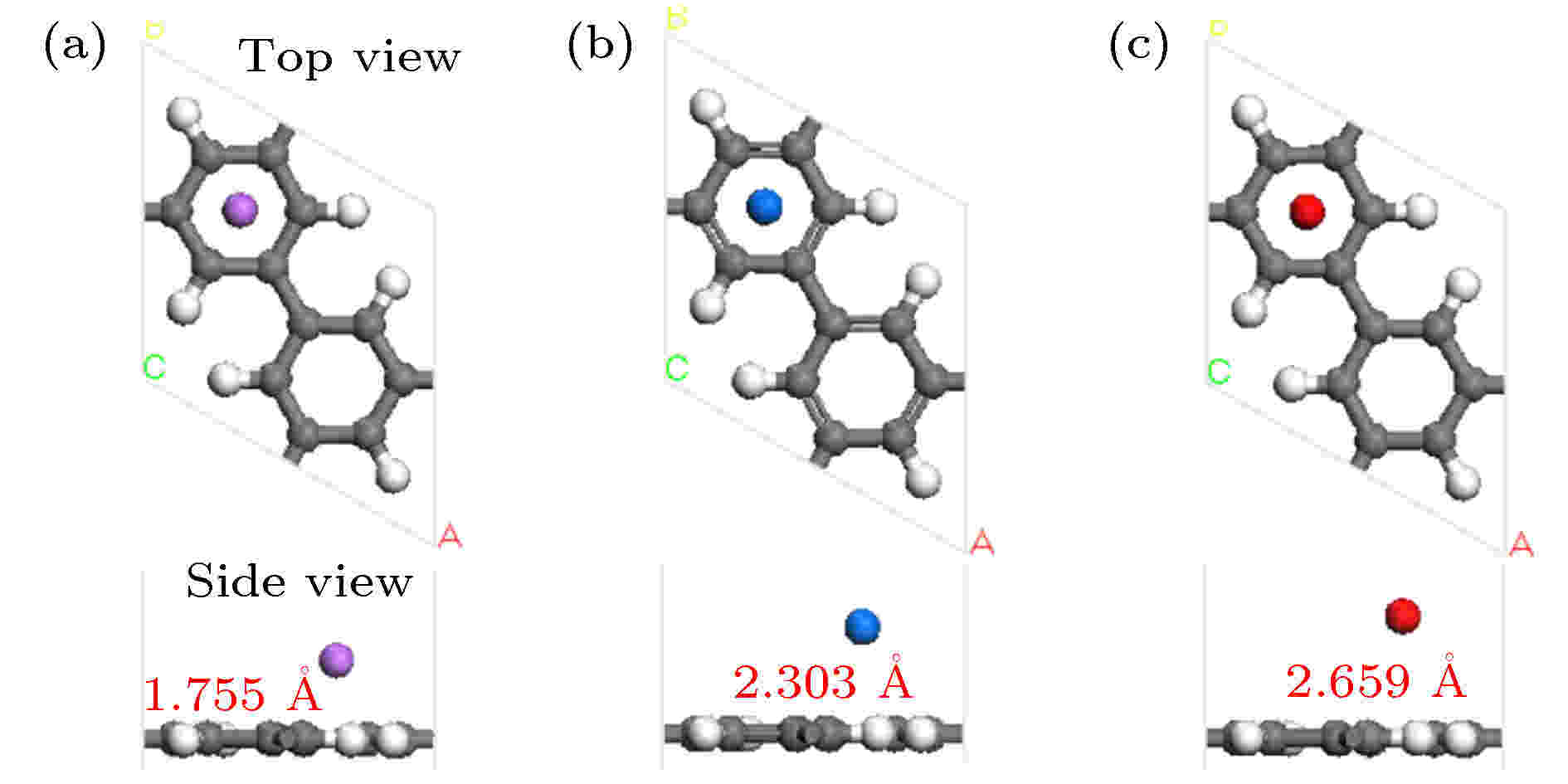
2020, 69 (6): 068802.
doi: 10.7498/aps.69.20190694
Abstract +
Porous graphene (PG), a kind of graphene-related material with nanopores in the graphene plane, exhibits novel properties different from those of pristine graphene, leading to its potential applications in many fields. Owing to periodic nanopores existing naturally in the two-dimensional layer, PG can be used as an ideal candidate for hydrogen storage material. High hydrogen storage capacity of Li-decorated PG has been investigated theoretically, but the effect of temperature on the stability of the H2 adsorbed on Li-PG has been not discussed yet. In this paper, by using the first-principles method, the hydrogen storage capacity on alkaline metal atoms (Li, Na, K) decorated porous graphene is investigated in depth with generalized gradient approximation, and the effect of the temperature on the stability of the hydrogen adsorption system is elucidated by the ab initio molecular-dynamics simulation. The results show that the most favorable adsorption sites of Li, Na and K are the hollow center sites of the C hexagon, and four alkaline metal atoms can be adsorbed stably on both sides of PG unit cell without clustering. Alkaline metal adatoms adsorbed on PG become positively charged by transferring charge to PG and adsorbed H2 molecules, and three H2 molecules can be adsorbed around each alkaline metal atom. By analyzing the Mulliken atomic populations, charge density differences and density of states of H2 adsorbed on Li-PG system, we find that the H2 molecules are adsorbed on alkaline metal atoms decorated graphene complex by attractive interaction between positively charged alkaline metal adatoms and negatively charged H and weak van der Waals interaction. Twelve H2 molecules are adsorbed on both sides of PG decorated with alkaline metal atoms. The average adsorption energy of H2 adsorbed on Li-PG, Na-PG and K-PG are –0.246, –0.129 and –0.056 eV/H2, respectively. It is obvious that the hydrogen adsorption capacity of Li-PG system is strongest, and the hydrogen adsorption capacity of K-PG is weakest, thus K-PG structure is not suitable for hydrogen storage. Furthermore, by the ab initio molecular-dynamic simulation, in which the NVT ensemble is selected but the external pressure is not adopted, the effect of temperature on the stability of H2 molecules adsorbed on Li-PG system is elucidated. The result shows that the configuration of Li-PG is very stable, H2 molecules are stably adsorbed around the Li atoms at low temperature, and some H2 molecules start to be desorbed from the Li atoms with the increase of temperature. At 200 K, H2 molecules begin to move away from Li atoms, and two H2 molecules escape from the binding of the Li atoms at 250 K. At 300 K, nine H2 molecules can be stably absorbed on both sides of Li-PG, and the gravimetric hydrogen storage capacity can reach up to 9.25 wt.%, which is much higher than the the US Department of Energy target value of 5.5 wt.% for the year 2017. With the increase of temperature, more adsorbed H2 molecules are desorbed, seven H2 molecules can be desorbed at 400 K, and all H2 molecules are completely desorbed in a temperature range of 600–700 K.
GEOPHYSICS, ASTRONOMY, AND ASTROPHYSICS
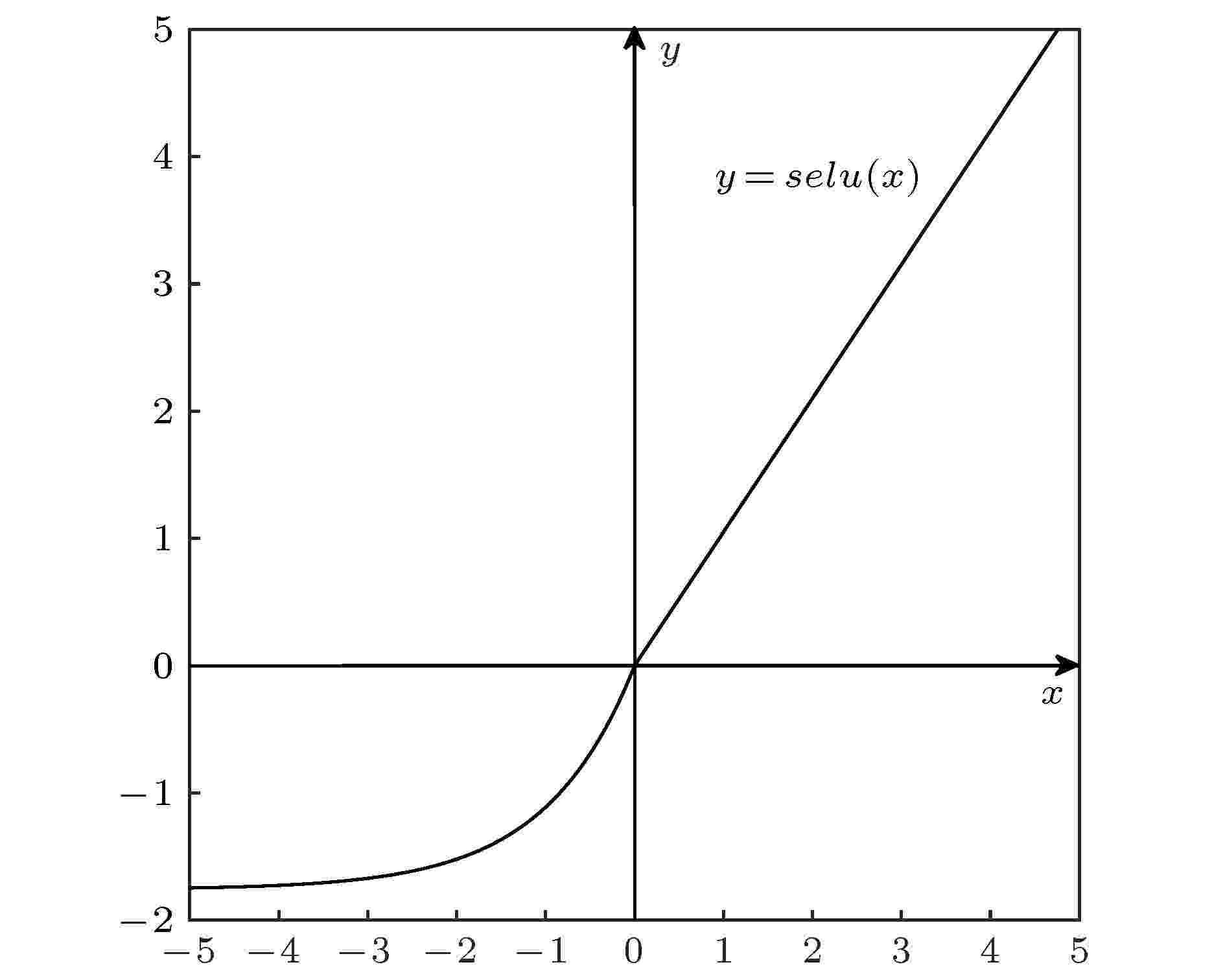
2020, 69 (6): 069701.
doi: 10.7498/aps.69.20191582
Abstract +
Pulsar candidate selection is an important step in the search task of pulsars. The traditional candidate selection is heavily dependent on human inspection. However, the human inspection is a subjective, time consuming, and error-prone process. A modern radio telescopes pulsar survey project can produce totally millions of candidates, so the manual selection becomes extremely difficult and inefficient due to a large number of candidates. Therefore, this study focuses on machine learning developed in recent years. In order to improve the efficiency of pulsar candidate selection, we propose a candidate selection method based on self-normalizing neural networks. This method uses three techniques: self-normalizing neural networks, genetic algorithm and synthetic minority over-sampling technique. The self-normalizing neural networks can improve the identification accuracy by applying deep neural networks to pulsar candidate selection. At the same time, it solves the problem of gradient disappearance and explosion in the training process of deep neural networks by using its self-normalizing property, which greatly accelerates the training process. In addition, in order to eliminate the redundancy of the sample data, we use genetic algorithm to choose sample features of pulsar candidates. The genetic algorithm for feature selection can be summarized into three steps: initializing population, assessing population fitness, and generating new populations. Decoding the individual with the largest fitness value in the last generation population, we can obtain the best subset of features. Due to radio frequency interference or noise, there are a large number of non-pulsar signals in candidates, and only a few real pulsar signals exist there. Aiming at solving the severe class imbalance problem, we use the synthetic minority over-sampling technique to increase the pulsar candidates (minority class) and reduce the imbalance degree of data. By using k-nearest neighbor and linear interpolation to insert a new sample between two minority classes of samples that are close to each other according to certain rules, we can prevent the classifier from becoming biased towards the abundant non-pulsar class (majority class). Experimental results on three pulsar candidate datasets show that the self-normalizing neural network has higher accuracy and faster convergence speed than the traditional artificial neural network in the deep structure, By using the genetic algorithm and synthetic minority over-sampling technique, the selection performance of pulsar candidates can be effectively improved.









